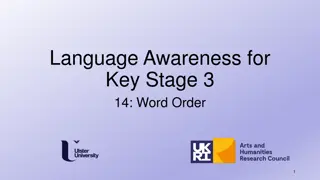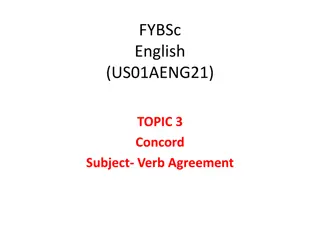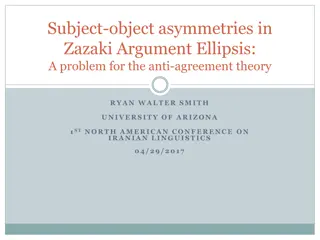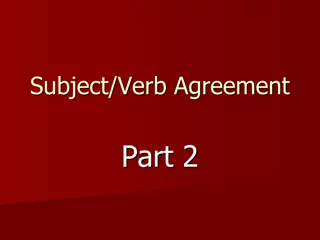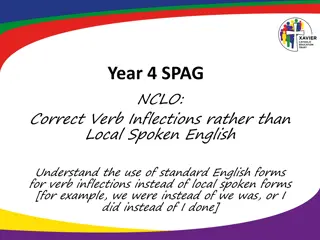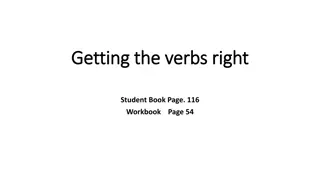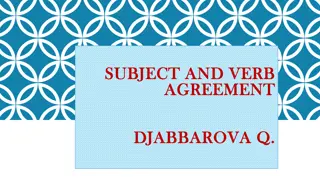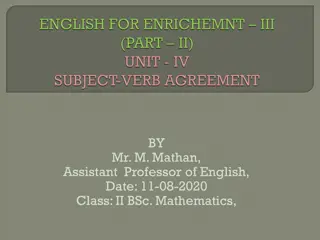Mastering Subject-Verb Agreement Rules in English Writing
Understand how to ensure proper subject-verb agreement in English sentences through clear explanations and visual examples. Learn the rules for different sentence structures and improve your writing accuracy.
Download Presentation

Please find below an Image/Link to download the presentation.
The content on the website is provided AS IS for your information and personal use only. It may not be sold, licensed, or shared on other websites without obtaining consent from the author.If you encounter any issues during the download, it is possible that the publisher has removed the file from their server.
You are allowed to download the files provided on this website for personal or commercial use, subject to the condition that they are used lawfully. All files are the property of their respective owners.
The content on the website is provided AS IS for your information and personal use only. It may not be sold, licensed, or shared on other websites without obtaining consent from the author.
E N D
Presentation Transcript
The Everyday Writer Andrea A. Lunsford
To make a verb in the present tense agree with a third-person singular subject, add s or esto the base form. A vegetarian diet lowers the risk of heart disease. What you eat affects your health.
To make a verb in the present tense agree with any other subject, use the base form of the verb. I miss my family. They live in another state.
Have and be do not follow the s or es pattern. Have changes to has; be has irregular forms in both present and past tenses. War is hell. The soldier was brave beyond the call of duty.
Make sure the verb agrees with the subject and not with another noun that falls in between. A vase of flowers makes a room attractive. have Many books on the best-seller list has little literary value
was A passenger, as well as the driver, were injured in the accident.
Subjects joined by and generally require a plural verb form. were A backpack, a canteen, and a rifle was issued to each recruit. George W. Bush s older brother and political ally was the governor of Florida. remains Drinking and driving remain a major cause of highway accidents and fatalities.
If the word each or every precedes subjects joined by and, the verb form is singular. Each boy and girl chooses one gift to take home.
With subjects joined by or or nor, the verb agrees with the part closer or closest to the verb. Either the witnesses or the defendant is lying.
Nouns like family, team, audience, group, jury, crowd, band, class, and committee refer to a group and can take either singular or plural verbs depending on whether they refer to the group as a single unit or to the members. After deliberating, the jury reports its verdict. The jury still disagree on a number of counts.
Two-thirds of the park has burned. Two-thirds of the students were commuters. Where are my reading glasses? The number of applicants for the internship was amazing. A number of applicants were put on the waiting list.
Most take singular verb forms. Of the two jobs, neither holds much appeal. Both, few, many, others, and several are plural. Though many apply, few are chosen. All, any, enough, more, most, none, and some can be singular or plural, depending on the noun they refer to. All of the cake was eaten.
The verb should agree with the antecedent of the pronoun. Fear is an ingredient that goes into creating stereotypes. Guilt and fear are ingredients that go into creating stereotypes. work Carla is one of the employees who always works overtime.
Verb should agree with the subject NOT the complement. are The three key treaties is the topic of my talk.
Some words that end in s appear plural but are singular. strikes Measles still strike many Americans.
Make the verb agree with the subject, not with a noun that happens to be before it. stand Beside the barn stands silos filled with grain. In sentences beginning with there is or there are, there is NOT the subject. There are five basic positions in the classical ballet.
describes One Writer s Beginnings describe Eudora Welty s childhood. is Steroids are a little word that packs a big punch in the world of sports.




